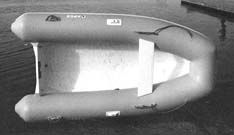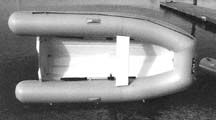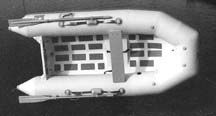Early inflatables were often little more than rubber rafts with an outboard motor bracket attached. They were slow and not very maneuverable, but they did stow in a small space.

The next step was the introduction of floorboards and either wooden keelsons or inflatable keels as well as rigid transoms. These dramatically improved performance, but at the expense of easy stowability. They also were more of a pain to set up, with lots of loose pieces that could find their way overboard if you were assembling the boat in rough conditions. They did, however, introduce a growing number of people to some of the advantages of inflatables, as compared to rigid dinghies. Inflatables were lighter, roomier (for the same length boat), much more stable both underway and upon boarding, and had much greater load capacities. They also carried their own built-in fenders, which is a considerable advantage when you are trying to tie up to your big boat in a chop. Their lower freeboard also made them ideal for rescue work, or as a dive boat or swimming float.
The next step in the inflatable’s development came with the introduction of the built-in rigid floor. This consists of either an air floor (a high-pressure inflated mat that functions as the inflatable’s sole) or a roll-up (a series of sewn-in slats that butt against each other when the boat is unrolled and are locked in place when the boat is inflated). Both designs work (see PS, June 1, 1997), with the air-floor models providing lighter weight and the roll-ups tending to provide a more-rigid structure. These designs have proven so successful that removable floorboard models have all but vanished from the marketplace.
Despite all of the various bottom-stiffening approaches, the hull configurations possible with a soft-bottomed inflatable are limited. Hence the introduction of the RIB, or rigid-bottom inflatable boat. RIBs offer the potential for better steering, higher speeds and a more solid ride than can be obtained with their softer-bottomed counterparts. They’re capable of quite respectable speeds (15-20 knots for a 10′ model) with limited horsepower (8-15-hp. is common for this size boat), can handle well and can be converted into craft that can double as tenders/sportboats.
RIBs don’t, of course, stow well. You can deflate the surrounding tubes, but you’re still left with a fairly bulky bundle. Stowage is a problem that’s been attacked, if not completely solved, by towing instead of stowing, by keeping the inflated boat in davits or flush against the transom, or by hauling it up to the deck or cabin top.
Along with the performance improvements that RIBs have brought to inflatable tenders has come a steady increase in weight—a real consideration when it comes to launching. The weight of both boat and engine is often enough to put buyers off RIBs altogether. Manufacturers recognized this and a new breed of RIB is emerging—lightweight models capable of sparkling performance with smaller (and lighter) outboards.
While inflatables have many important advantages over the traditional rigid dinghy, they have one major disadvantage—they don’t row well. And that includes RIBs. While they come with oars, rowing is a chore best reserved for cases of engine failure.
Lightweight RIBs
A typical RIB in the 10-foot range—a popular size for tenders—weighs in at a hefty 140 or so pounds, without a motor. Typically, an 8-hp. to 9.9-hp. motor will weigh another 70-75 pounds. That’s a lot to handle, especially if you’re single-handing it.

The new breed of lightweight RIBs dramatically reduces that load. The Apex, the heaviest of the three tenders tested, weighs 98 lbs. The Aria, the lightest, tips the scales at a svelte 72 lbs. The aluminum-bottomed Zodiac is intermediate in weight, at 82 lbs. How do they achieve this weight loss? Simply by putting the rigid bottom itself on a diet.
Normal RIBs have a double-wall hull—the flat sole (floor) section and the V-shaped hull below it. This construction has the obvious advantage of structural rigidity; most RIBs of this type maintain stiffness even if one or more of the air tubes deflates. And, the flat sole is much more convenient underfoot than a slanted, wedge-shaped floor.
All three of the lightweight RIBs we tested eliminate the floor piece, the major factor in achieving weight reduction. While some of the hulls are stiffer than others, all rely to some extent upon having fully inflated air tubes to achieve the desired degree of stiffness. This is more a minor concern than a real problem because an inflatable with one or more tubes deflated isn’t apt to be driven at speeds where hull rigidity is important. On the other hand, it behooves the owner of a lightweight RIB to top up the air pressure in a tube that’s going soft.
Single-piece floor/hull construction limits the size of the motor you can use on the boat: The Apex and Zodiac are rated at 15 hp. maximum,

while the Aria is rated for up to 10 hp. “Heavyweight” RIBs of a comparable size are typically rated for 25 hp. None of the lightweights, however, had a problem planing with a 9.8-hp. motor, even with a 450-lb. load, and the additional speed that can be obtained with a larger engine is minimal. We tried a 15-hp. engine on the Apex, and found no measurable increase in top speed over what we obtained with a 9.8 hp.
Models Tested
We encountered the Apex A-10 Lite at a boat show. It sounded like an interesting concept, especially in conjunction with Nissan’s new lightweight 9.8-hp. motor, so we borrowed one from the manufacturer for testing (we’ll report on it later). Shortly after this, Steve Lance of Defender Industries told us of two other lightweights—the Aria 310 and the Zodiac YL310A—and agreed to provide a sample of each for a shootout comparison. All three are similar in size (10′ 0″, 10′ 2″ and 10′ 2″ respectively), and all three are reasonably light in weight.
All are clearly aimed at the same market…the cruiser who is looking for a more manageable high-performance inflatable tender.
The Tests
We ran each boat with an 8-hp. and a 9.8-hp. motor and with loads of 200 lbs. and 450 lbs., measuring top speed. We then measured acceleration with a stopwatch, using a “dragstrip” consisting of a series of floats spaced 30′ apart on a length of yellow polypropylene line that was anchored at each end. We checked maneuverability and handling by executing a series of sharp and not-so-sharp turns at various speeds. We stood up in each boat while adrift and walked around, judging stability and skid-resistance of the hull. We drove each boat at top speed through the roughest chop we could find (it was a calm day, unfortunately) and through boat wakes to get a handle on seaworthiness. We compared hull flex with true scientific precision…by placing a foot across the aft section of the floor and feeling how badly the hull flexed. And finally, we took each one out for a spin to see how we liked it overall.
Results
While the three boats tested are similar in size, they’re very different in terms of construction. The Apex hull is made of fiberglass, the Aria of ABS (acrylonitrile/butadiene/styrene) and the Zodiac hull is a formed sheet of aluminum. Fiberglass and aluminum are well-known and well-established boatbuilding materials. ABS is less so, though it’s been widely used for small freshwater craft such as canoes and kayaks, and is widely used for a range of land-based products such as automobile bumpers and front-end assemblies.
Hull designs of the three also differed considerably. The Zodiac’s aluminum hull has a fairly deep V extending back to the stern, with four longitudinal strakes, whose major function is probably to stiffen the hull. The Aria has a somewhat shallower V, while the Apex has flattened center sections at the stern to enhance planing.
Any of these three boats would make a versatile tender with sprightly performance. There are differences, though.
Apex A-10 Lite
The Apex A-10 Lite is similar in design to Apex’s conventional RIB, though it lacks some of the niceties of the heavier model. There’s no grab line at the rail, which we find to be a minor, but irritating omission. Similarly, there is no tiedown strap for securing the oars.
At 98 lbs., it’s the heaviest of the three boats, though it’s still light enough to be considered a lightweight. We missed the molded rubber carrying handles/cleats that the heavier Apex has mounted at the bow and aft on the tubes; instead there are rope loops, which are adequate but not nearly as nice. The Apex’s flat aft section makes for easier and more secure boarding than the other two.
On the water, the Apex showed impeccable manners. It planed easily and quickly with either the 8-hp. or the 9.8-hp. motor, reaching a top speed of 16.6 knots with the smaller powerplant and a heavy (450 lb.) load; with the 9.8 hp engine and the same load it topped out at 19.6 knots. Results in our acceleration runs, we’ve found, depend wholly on how fast the boat gets up on plane. The Apex beat out the others handily, negotiating our course in 15.1 seconds (with the 9.8-hp. engine and a 450-lb. load), and 17.1 seconds with the 8 hp.
Handling was precise and smooth at all speeds, with a very slight degree of skidding in high-speed turns. Steering was always predictable; tracking was excellent. The ride was smooth, dry and comfortable. We could detect no evidence of hull flexing during our tests.
Bottom Line: The heaviest (by 16 lbs.) and the most skimpily equipped of the three boats, the Apex A10 Lite was the winner in the performance tests. It was also the best in terms of ease of boarding. If you can tolerate the weight, and are willing to attach some miscellaneous lines and straps, the Apex is our top choice among the three.
Aria 310
The Aria line is made by Artigiana Battelli (AB) in Caracas, Venezuela. The 310 is the lightest of the three boats tested, tipping the scales at a mere 72 lbs., a full 26 pounds lighter than the Apex. It’s reasonably nicely fitted out, with tiedown straps for the oars and a grab rope that extends along the side tube for the full length of the cockpit. It’s also a bit more square in plan view than either of the others, providing more useful space forward. The V bottom made for a less comfortable footing than the Apex’s flatter floor.
Performance was very good. We noticed some flexing in the hull during high-speed runs, which would have been exacerbated by underinflated tubes. As it was, the flex was a bit unnerving, but not a serious problem. Planing was smooth and fairly quick, with either engine. We recorded top speeds of 16.1 and 19.2 knots with a heavy load. Acceleration figures were presentable: 16.1 seconds with the 9.8 hp. and 18.4 seconds with the smaller outboard.
Handling was excellent—quick and precise with very little skidding. Tracking was excellent.
For rigidity, the Aria depends much more than the other two on support from the air tubes. When we let some air out of one of the tubes, producing the kind of underinflation that’s apt to result from putting a fully inflated boat into cold water, flex became more severe. This may be why the manufacturer derated the boat from its original 15 hp. to 10 hp.
Bottom Line: Very light. The V-shape may make boarding more difficult. Performance was very good, but not quite as fast as the Apex. We haven’t encountered ABS as a material for a powerboat hull before, but the amount of flex, and the apparent necessity for limiting the horsepower makes us a bit unsure about the ultimate longevity of this unreinforced plastic for the hull. If you’re not planning on pushing it hard, and the weight is of paramount importance, the Aria appears to warrant consideration.
Zodiac YL310A
Above the rigid hull, the Zodiac YL 310 A is identical to Zodiac’s Cadet YL 310. The hull itself is made of aluminum instead of fiberglass. The YL 310 A’s 4′ 11″ beam is narrower than the Apex (5′ 7″) and the Aria (5′ 3″). Its 82-lb. weight is intermediate between the other two. To help provide a good foothold, there are 22 patches of nonskid material glued to the sole. These are effective, but we wonder how long they’ll stay in place. The deepish V makes footing less than secure, even with the nonskid.
The Zodiac is the best fitted out of the three boats. It comes with carrying handles, oar and fuel-tank tiedowns, a hefty rubrail and molded buttons attached to the air tubes at strategic places to permit attachment of accessories, such as storage bags.
Performance with the 9.8-hp. engine was good. With the 8-hp. we couldn’t get the boat to plane with the heavy 450-lb. load, and only with great difficulty with the light 200-lb. load. Top speed recorded with the 8-hp. motor and a light load was 15.8 knots, but that involved some weight shifting by the operator; with a heavy load we topped out at 5.2 knots. With the 9.8-hp. motor, we reached 19.2 knots even with the heavy load. Acceleration runs with the 8-hp. engine proved futile; we just couldn’t get the boat to plane. Running the measured course with the larger engine, the best we could achieve was 27.3 seconds. This helps confirm what we noted in a previous test of RIBs: While a deep V bottom pounds less than flatter bottoms, it also makes planing more difficult.
In every test, the Zodiac showed itself to be extremely rigid. We detected no flex, but this rigidity also resulted in a harsher ride.
The Zodiac ran and tracked very well, but no better than the other two; a sharper V can be expected to provide a softer ride and better tracking, but we couldn’t discern a difference. Steering was extremely precise…so much so that even a minor twitch of the tiller caused a fairly drastic change of direction. This is a trait that you can get used to, but it does make high-speed running a bit nerve-wracking for someone not familiar with it.
One characteristic of the Zodiac we didn’t like was the noise level. The entire aluminum hull resonated with the engine, which we found unpleasant.
Bottom Line: The Zodiac YL310A is well-fitted and very rigid. It’s the only one of the three boats that uses welded PVC instead of glued Hypalon for its airtubes. The debate about Hypalon vs. PVC hasn’t been settled yet (and probably won’t be until someone comes up with a fabric that makes obsolete both materials), but the consensus of repairmen we’ve spoken to seems to be that in the tropics Hypalon outlasts PVC; in temperate climes there’s no clear picture of which is best.
The Zodiac requires more power than the Aria and the Apex to achieve good performance. Its very precise steering can make for twitchy operation, and its narrower beam and deeper V makes boarding less secure. Lastly, its noisy.
Conclusion
All three boats provide exhilarating performance, as well as half-ton carrying capacity in a more-or-less lightweight package. Of the three, we prefer the Apex, primarily because of the edge it has in performance, but also because we have more confidence in its use of tried-and-true materials.
The Aria performed almost as well; we think it merits strong consideration if its 26-lb. weight advantage is important.
The Zodiac, while well fitted-out and very rigid, has, in our opinion, too many shortcomings.
Also With This Article
Click here to view “Value Guide: Lightweight RIBs.”
Contacts- Apex Inflatables, 919A Bay Ridge Rd., Annapolis, MD 21403; 800/422-5977, www.apexinflatables.com. AB Inflatables. Aria (AB Inflatables), Action Marine Distributors, 57A Lafayette Ave., Suffern, NY 10901; 914/368-3798; www.InflatableBoatParts.com, www.abinflatables.com. Zodiac of North America, PO Box 400, 540 Thompson Creek Rd., Stevensville, MD 21666; 410/643-4141, www.zodiac.com.
































